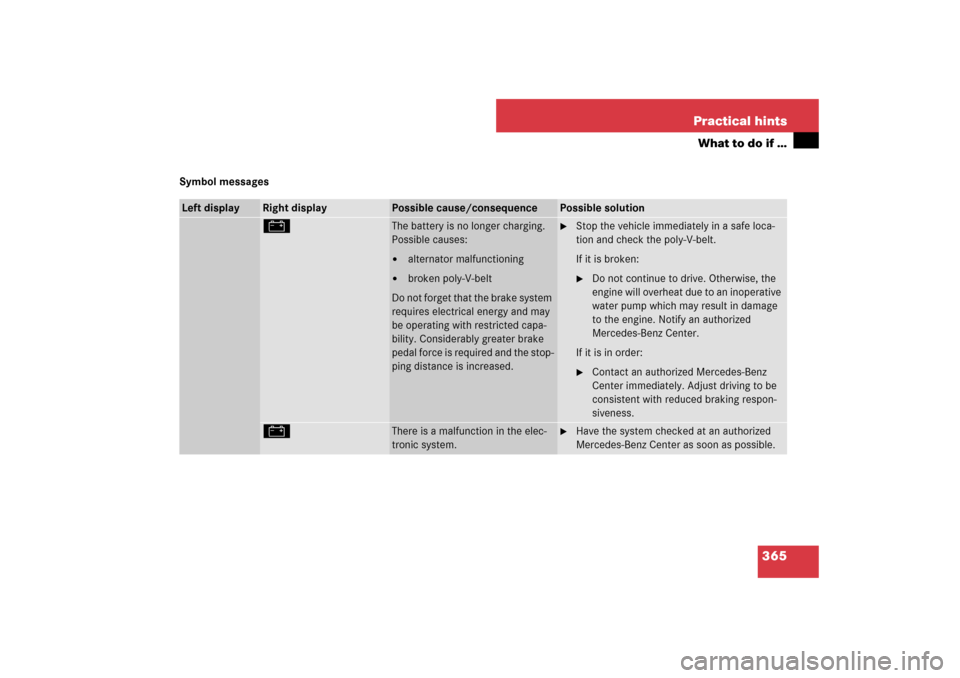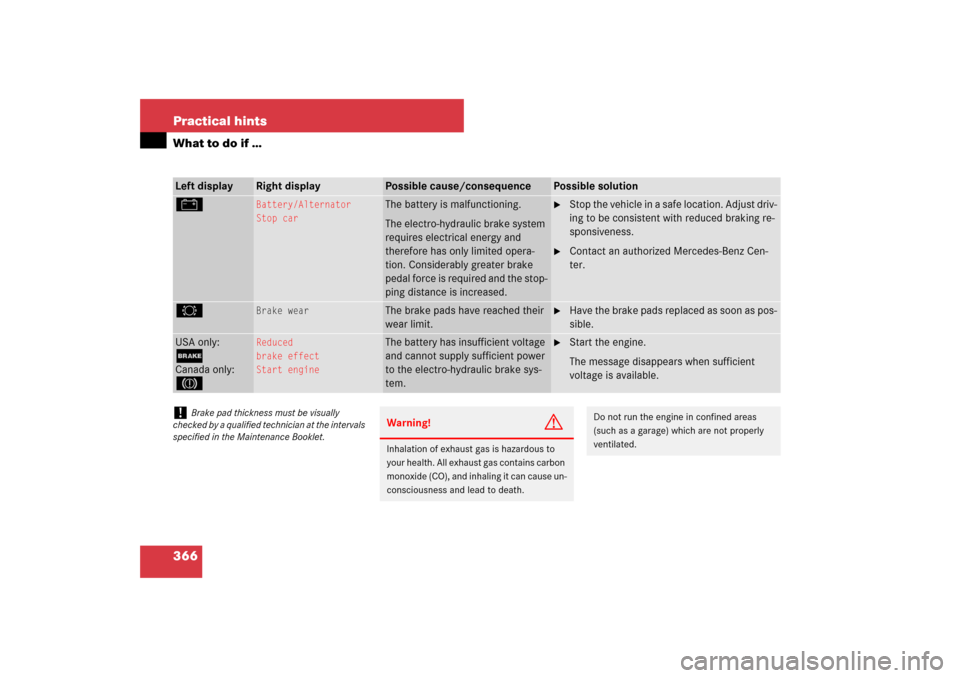Page 366 of 473

365 Practical hints
What to do if …
Symbol messagesLeft display
Right display
Possible cause/consequence
Possible solution
#
The battery is no longer charging.
Possible causes:�
alternator malfunctioning
�
broken poly-V-belt
Do not forget that the brake system
requires electrical energy and may
be operating with restricted capa-
bility. Considerably greater brake
pedal force is required and the stop-
ping distance is increased.
�
Stop the vehicle immediately in a safe loca-
tion and check the poly-V-belt.
If it is broken:�
Do not continue to drive. Otherwise, the
engine will overheat due to an inoperative
water pump which may result in damage
to the engine. Notify an authorized
Mercedes-Benz Center.
If it is in order:
�
Contact an authorized Mercedes-Benz
Center immediately. Adjust driving to be
consistent with reduced braking respon-
siveness.
#
There is a malfunction in the elec-
tronic system.
�
Have the system checked at an authorized
Mercedes-Benz Center as soon as possible.
Page 367 of 473

366 Practical hintsWhat to do if …Left display
Right display
Possible cause/consequence
Possible solution
#
Battery/Alternator
Stop car
The battery is malfunctioning.
The electro-hydraulic brake system
requires electrical energy and
therefore has only limited opera-
tion. Considerably greater brake
pedal force is required and the stop-
ping distance is increased.
�
Stop the vehicle in a safe location. Adjust driv-
ing to be consistent with reduced braking re-
sponsiveness.
�
Contact an authorized Mercedes-Benz Cen-
ter.
2
Brake wear
The brake pads have reached their
wear limit.
�
Have the brake pads replaced as soon as pos-
sible.
USA only:;Canada only:3
Reduced
brake effect
Start engine
The battery has insufficient voltage
and cannot supply sufficient power
to the electro-hydraulic brake sys-
tem.
�
Start the engine.
The message disappears when sufficient
voltage is available.
!
Brake pad thickness must be visually
checked by a qualified technician at the intervals
specified in the Maintenance Booklet.
Warning!
G
Inhalation of exhaust gas is hazardous to
your health. All exhaust gas contains carbon
monoxide (CO), and inhaling it can cause un-
consciousness and lead to death.
Do not run the engine in confined areas
(such as a garage) which are not properly
ventilated.
Page 416 of 473

415 Practical hints
Batteries
!
The factory-equipped VRLA battery is
leak-proofed. Only use a battery as replacement
that has the same security features and is of
identical size, voltage, and capacity as the
factory-equipped battery.
The battery, the battery ventilation and the later-
al plug must always be securely installed when
the vehicle is in operation.
Warning!
G
Failure to follow these instructions can re-
sult in severe injury or death.
Never lean over batteries while connecting,
you might get injured.
Battery fluid contains sulfuric acid. Do not
allow this fluid to come in contact with eyes,
skin or clothing. In case it does, immediately
flush affected area with water and seek
medical help if necessary.
A battery will also produce hydrogen gas,
which is flammable and explosive. Keep
flames or sparks away from battery, avoid
improper connection of jumper cables,
smoking, etc.
!
Never loosen or detach battery terminal
clamps while the engine is running or the
SmartKey is in the starter switch. Otherwise the
alternator and other electronic components
could be severely damaged.
Have the starter battery checked regularly by an
authorized Mercedes-Benz Center.
Refer to Maintenance Booklet for maintenance
intervals or contact an authorized
Mercedes-Benz Center for further information.
Warning!
G
Do not place metal objects on the battery as
this could result in a short circuit.
Use leak-proof batteries only to avoid the
risk of acid burns in the event of an acci-
dent.
Warning!
G
The brake system requires electrical power
to operate.
A malfunction in the vehicle’s power supply
or electrical system may impair brake sys-
tem operation and switch it into its emer-
gency operation mode. The same applies if
battery is disconnected. To brake, the driver
must then apply significantly greater brake
pedal pressure and depress the pedal much
further to obtain the expected braking ef-
fect. If necessary, apply full pressure to the
brake pedal. Brakes are only applied to the
front wheels. Stopping distance is in-
creased! Adjust your driving style according-
ly. For more information, see
“Electro-hydraulic brake system”
(�page 92).
Page 433 of 473
432 Technical dataLayout of poly-V-belt driveSL 550
1Idler pulley
2Idler pulley
3Automatic belt tensioner
4ABC tandem pump (pump for
power-steering assistance and ABC
chassis)
5Air conditioning compressor
6Crankshaft
7Coolant pump
8Generator (alternator)
SL 55 AMGThe SL 55 AMG has two poly-V-belts (belt
one shown in purple/belt two shown in
black).1Idler pulley
2Automatic belt tensioner
3ABC tandem pump (pump for
power-steering assistance and ABC
chassis)
4Air conditioning compressor
5Crankshaft
6Coolant pump
7Generator (alternator)
8Idler pulley
9Automatic belt tensioner
aSupercharger
SL 600, SL 65 AMG
1Automatic belt tensioner
2ABC tandem pump (pump for
power-steering assistance and ABC
chassis)
3Air conditioning compressor
4Crankshaft
5Coolant pump
6Generator (alternator)
7Idler pulley
8Idler pulley
9Idler pulley
Page 442 of 473
441 Technical data
Electrical system
�Electrical system
Model
SL 550
SL 600
SL 55 AMG
SL 65 AMG
Generator (alternator)
14 V/150 A
14 V/180 A
14 V/180 A
14 V/180 A
Starter motor
12 V/1.7 kW
12 V/1.7 kW
12 V/1.7 kW
12 V/1.7 kW
Starter battery
12 V/35 Ah
12 V/35 Ah
12 V/35 Ah
12 V/35 Ah
Battery for electrical consumers
12 V/70 Ah
12 V/70 Ah
12 V/70 Ah
12 V/70 Ah
Spark plugs
Bosch Y 7 MPP 33
NGK PLKR6A
NGK IFR6QG
NGK ILFR6A
NGK IFR6QG
Electrode gap
0.031 in (0.8 mm)
0.028 in (0.7 mm)
0.031 in (0.8 mm)
0.028 in (0.7 mm)
Tightening torque
15 – 18 lb-ft
(20 – 25 Nm)
18 – 22 lb-ft
(25 – 30 Nm)
18 – 22 lb-ft
(25 – 30 Nm)
18 – 22 lb-ft
(25 – 30 Nm)